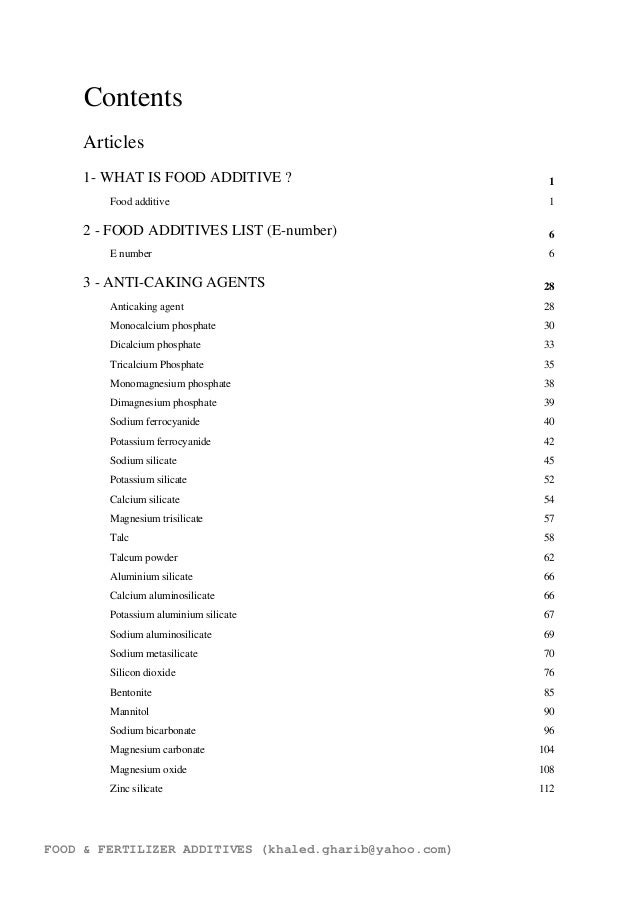
Most of the anti-caking agents are made from synthetic substances such as silicon dioxide or magnesium and calcium stearates solid saturated fatty acids However there are many ani caking agents that come from natural sources. Column 1 Additive Column 2 Permitted in or Upon Column 3.

Magnesium hydrogen carbonate is used mainly as a buffer and anti-caking agent but it is also used as an anti-bleaching agent.
List of anti caking agents. 56 rows This List of Permitted Anticaking Agents sets out authorized food additives that reduce adhesion of particles to maintain the texture of foodIt is incorporated by reference in the Marketing Authorization for Food Additives That May Be Used as Anticaking Agents. A transition guide has been created to provide stakeholders with further information on the Lists of Permitted Food. There are two types of anti caking agents- manufactured or man-made and natural anticaking agents.
Most of the anti-caking agents are made from synthetic substances such as silicon dioxide or magnesium and calcium stearates solid saturated fatty acids However there are many ani caking agents that come from natural sources. Anti-caking agents are suitable for bake mixes baking powders chili powders cocoa mixes cream substitutes dessert mixes egg powders essential oils flavors grated cheeses gravy mixes meat seasonings powdered milk powdered sugar salt soup mixes. There are two types of anti caking agents- manufactured or man-made and natural anticaking agents.
Most of the anti-caking agents are made from synthetic substances such as silicon dioxide or magnesium and calcium stearates solid saturated fatty acids However there are many ani caking agents that come from natural sources. The most widely used anticaking agents include the stearates of calcium and magnesium silica and various silicates talc as well as flour and starch. Ferrocyanides are used for table salt.
The following anticaking agents are listed in order by their number in the Codex Alimentarius. Other common anti-caking agents include. Silicon dioxide calcium silicate iron ammonium citrate and yellow prussiate of soda.
Several anti-caking agents have been cause for concern recently because of their name. In Europe sodium ferrocyanide 535 and potassium ferrocyanide 536 are more common anti-caking agents in table salt. Natural anticaking agents used in more expensive table salt include calcium carbonate and magnesium carbonate.
Some anti-caking agents are soluble in water. Others are soluble in alcohols or other organic solvents. There are two types of anti caking agents- manufactured or man-made and natural anticaking agents.
Most of the anti-caking agents are made from synthetic substances such as silicon dioxide or magnesium and calcium stearates solid saturated fatty acids However there are many ani caking agents that come from natural sources. Exfoliated hydrobiotite Verxite - FEED REG. Finished feed - In poultry swine or ruminant feed as anti- caking blending agent pelleting aid or nonnutritive carrier for incorporation.
Anti-caking agents solve this conundrum by either coating the particles themselves to shield them or absorbing moisture before the powder does. Anti-caking agents are added in very small amounts to powders and other food products like table salt spices milk powder flour sugar and many more pantry friendly items. There are anti-caking agents in table salt sea salt and both iodized and non-iodized versions of both.
If you wish to avoid such ingredients just inspect the containers in the salt aisle until you find one whose ingredients list contains solely. For example sodium aluminosilicate is used in sugar salt non-dairy creamers and more to absorb moisture microcrystalline cellulose aka powdered cellulose keeps our shredded cheese from clumping and calcium silicate prevents salts seasonings and dry mixes from caking. Anti-caking agents are a type of food additive.
Most famously depicted through Morton Salts When It Rains It Pours Campaigns that began as early as 1914 anti-caking agents were developed to keep ingredients from clumping together after being packaged. Magnesium hydrogen carbonate is used mainly as a buffer and anti-caking agent but it is also used as an anti-bleaching agent. Typical products include sugar salt other granular foods Journal Articles and References E535 Sodium ferrocyanide also an Acidity Regulator.
List of Anticaking Agents Approved For Baked Products. Here is the complete list of approved anticaking agents by CFIA that can be used in baked products or in ingredients for baked products and goods. Column 1 Additive Column 2 Permitted in or Upon Column 3.
An anticaking agent is an additive placed in powdered or granulated materials such as table salt or confectioneries to prevent the formation of lumps caking and for easing packaging transport flowability and consumption. We provides a below range of standards Anti Caking Agents. Anti-Caking Agent An anti-caking agent is a sort of additive used in the most type of powder and granulated food items or materials.
The most common anti-caking agents for fertilizers contain oils and fats to avoid the interaction of fertilizer particles with that of the atmosphere. Anti-caking agents are used so that the powdered or. Market Research Report Summary.
China Anti-Caking Agents for Fertilizer Market Report Forecast 2021-2027 report is published on August 13 2021 and has 93 pages in it. This market research report provides information about Manufacturing Chemicals Chemicals industry.